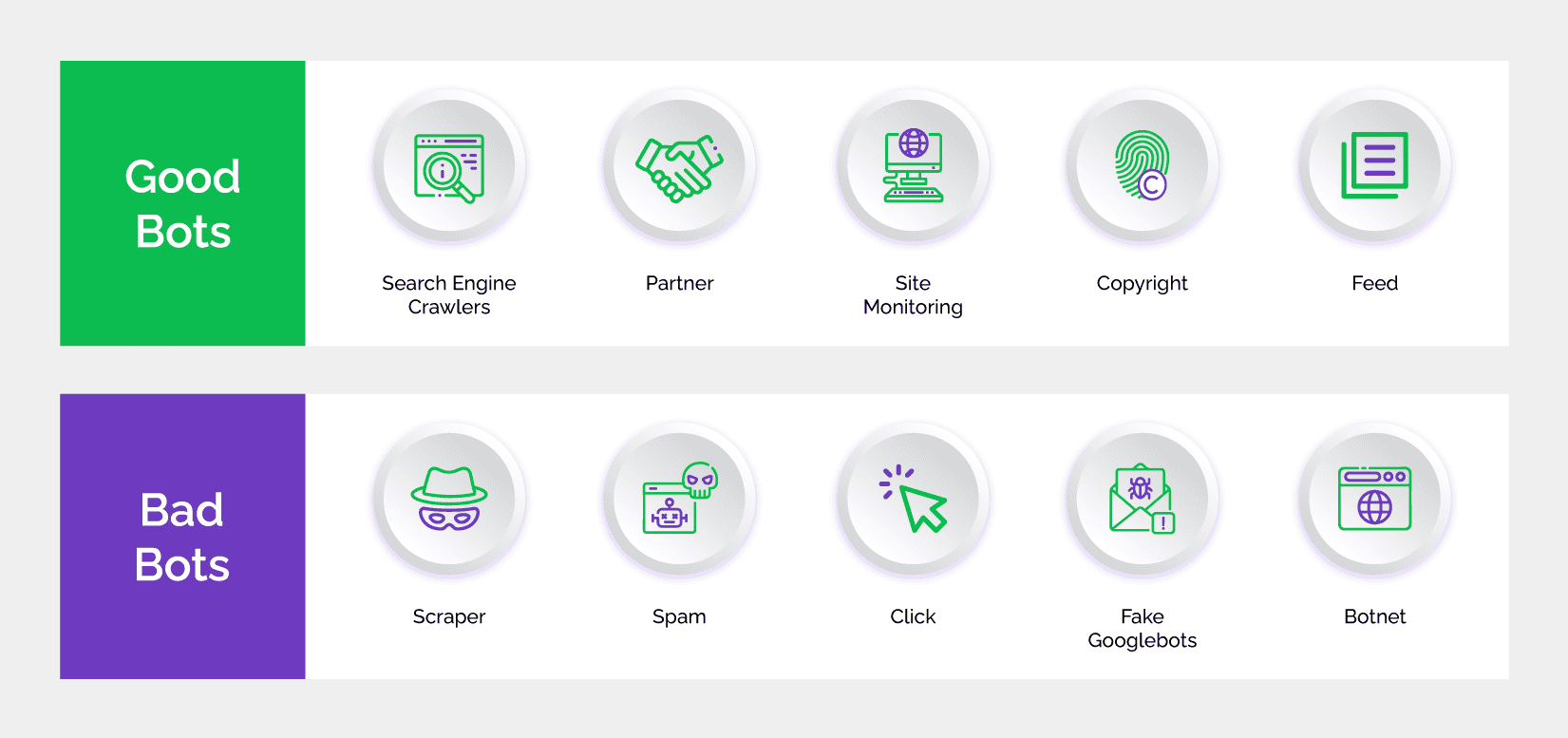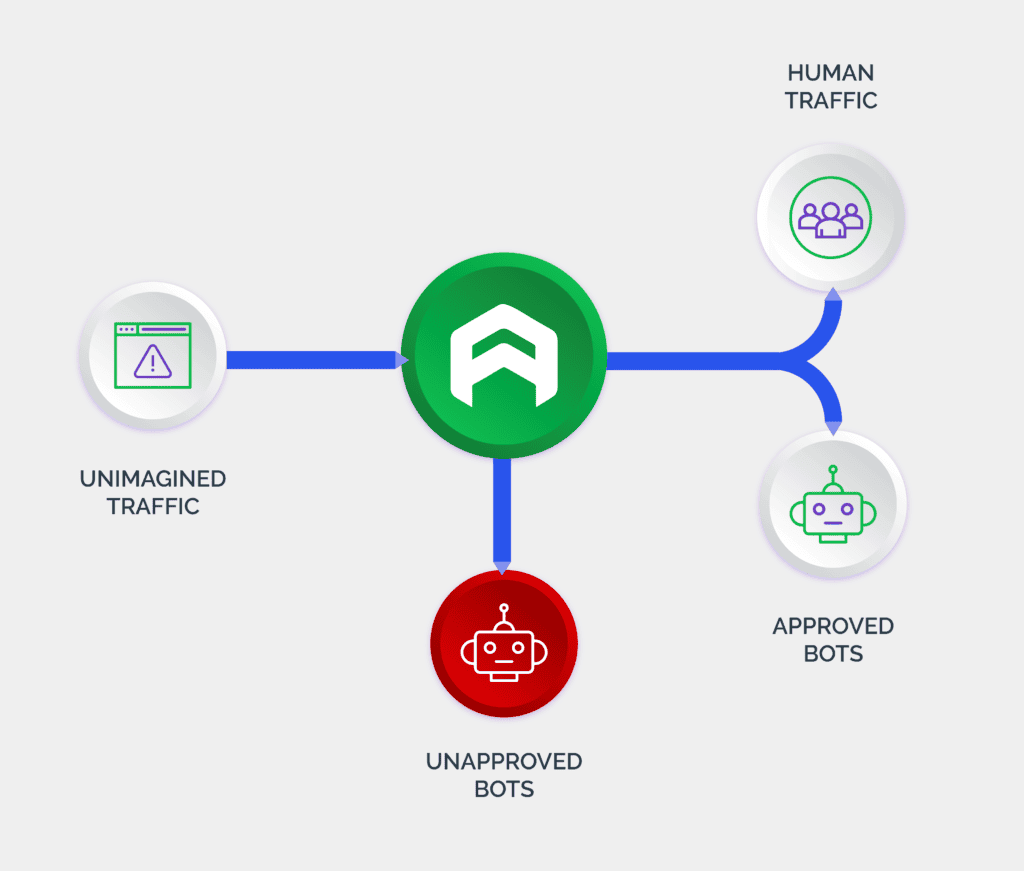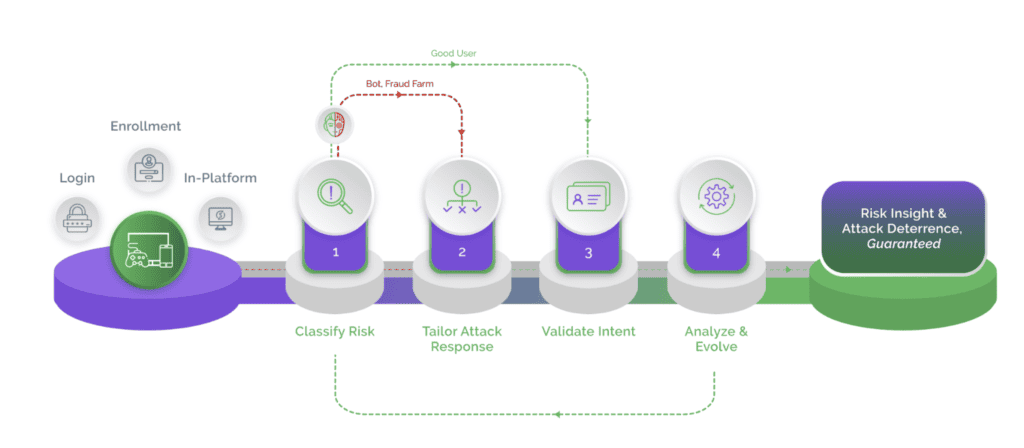Any non-human traffic on a website or an app is called bot traffic. Bots are a common occurrence on the internet and constitute nearly two-thirds¹ of the total internet traffic.
Bot traffic is generally considered dangerous. However, depending on their use, bots can also be beneficial, such as in services like digital assistants and search engines.
On the other hand, bad bots can be used to steal information and launch several types of attacks that can jeopardize business operations and adversely impact revenue and user experience. This is why it is essential for digital businesses to effectively manage bots visiting their digital platforms.

Should businesses block bot traffic?
Although good bots can improve visibility of businesses through search engines, bad bot traffic can cause immense harm by disrupting performance of the website, impacting security, and causing customer dissatisfaction. Bots are increasingly powering complex attacks including credential stuffing, account takeover, fake account generation, price scraping, and more. Therefore, businesses must be able to distinguish between useful and malicious bot traffic to take effective countermeasures to protect against bad bot traffic.
How does bot traffic affect business?
Malicious bots continue to pose a growing challenge for digital businesses. Not only are bots used to steal consumer and business information, huge amounts of bot traffic are also used to overwhelm digital platforms to slow down the page load speed, affecting visitor experience.
- Attacks: Large amounts of bot traffic can be used to launch distributed denial of service (DDoS) attacks, making websites unavailable to genuine customers. The delay in access to the platform, especially in the ecommerce and travel industries, can force customers to switch over to competitors, causing revenue losses to the affected businesses.
- Disruption: Bot traffic is also used to disrupt social media platforms by artificially inflating the number of followers or liking a post, influencing public opinion, tarnishing the image of public figures, and spreading disinformation that can lead to disharmony and conflicts.
- Performance: When bot traffic is used to attack pay-per-click ads, the advertising industry can suffer a setback in the form of distorted SEO results and skewed data analysis. This is because bot traffic can trigger fake ad clicks (click fraud), which affect the pay-per-click ads. Further, website performance is obliterated due to the deviations caused in the data, such as page views, time spent, bounce rate, user location, and so forth.
- Traffic: Unusually high bot traffic is often used to hoard inventories. Bots add enormous amounts of merchandise to the carts, which are not purchased, but only with the intention of preventing genuine customers from accessing them. Inventory hoarding obstructs efforts to improve conversion rates. On the contrary it increases cart abandonment rates. Often, bot traffic is used to scrape data, including personal information of consumers such as phone numbers and email IDs as well as sensitive business data, which is then used to facilitate phishing attacks.
- Data Loss: Data is also extracted by using bot traffic to infect devices with malware and taking control of the infected devices. These infected devices can be connected to form a botnet to launch more complex attacks at scale. Large volumes of bot traffic can hinder fraud prevention efforts by causing unnecessary noise.
Telltales of bot traffic
Detecting bots is crucial to maintaining overall security of the digital platform. However, security teams must ensure that bot detection does not lead to false positives or false negatives. There are certain telltales that can help security teams identify bot traffic. Some of these include:
- Pageviews: An abnormal spike in pageviews could likely be a handiwork of bots.
- Bounce rate: A high bounce rate could indicate heightened bot traffic to the website.
- Session duration: Increase or decrease in session durations – the time users spend on a website – should indicate bot activity as they may browse the websites much slower or faster, respectively than the humans.
- Conversions: Surge in form submissions, account creation, or conversions using fake user details can be due to bot traffic.
- Location-specific traffic: A spike in traffic from a specific geographical location, especially not the target customer base of the business could indicate bot traffic.
- IP-specific traffic: An increase in user requests from a single IP within a short duration could be bot traffic.
How can businesses manage bot traffic?
Since bot traffic has the potential to disrupt operational efficiency of digital platforms and expose them to heightened risks, it is imperative that businesses deploy appropriate countermeasures to stop bots from negatively impacting their business and user experience.
To identify bot traffic and preventing it from causing harm to their digital platforms, businesses can consider using the following:
- Robots.txt file: This file can be included to provide instructions for bots crawling the page. It can also be used to completely prevent bots from interacting with the website.
- CDN: A Content Delivery Network (CDN) is a distributed platform of servers that can help reduce delay in loading web pages. It also alleviates the risk of a sudden surge in bot traffic to help optimize the website performance.
- Add HTTPS: Adding HTTPS to the website creates an encrypted channel between the website and its users, providing better security to the information traversing between the server and the browser.
- Tools: Deploy tools such as rate limiting solutions, DDoS mitigation, Web Application Firewalls (WAF), and access control lists (ACL).
- Bot management solutions: Add a layer of security to detect and prevent bot traffic, especially intelligent bots that can mimic human behavior.
Hallmarks of a good bot detection solution
Considering the advancements in bot technology and human-like capabilities that bots have acquired, an effective bot detection solution should be able to block bots of all sophistication levels in real-time. That said, bot management solutions should integrate easily with other tools and existing security infrastructure of the organization to prevent undue addition to technical debt.

Why work with Arkose Labs for bot traffic management?
Malicious bot traffic can be a grave risk for digital platforms and cause financial and reputational losses. Rooting out bad bot traffic using an efficient bot management solution, such as Arkose Labs, should be a priority for digital businesses.

Global brands trust Arkose Labs for effective bot traffic management. Arkose Labs’ bot management solution accurately identifies bot traffic from humans and uses proprietary enforcement challenges to block them. Even the most intelligent and human-like bots cannot clear these challenges at scale because they are trained against the latest computer vision technologies, making them resilient to advanced capabilities of bots.
Using embedded machine learning, historical attack pattern calibration, and anomaly detection, Arkose Labs segments incoming according to the risk assessment. Further, using a ‘clear box’ approach to deliver actionable insights, Arkose Labs provides security teams with clear explanations for risk classifications and flexibility to segment traffic for remediation – through proprietary challenge-response technology. This combination of transparency and dynamic attack response allows security teams to efficiently manage bot traffic on their digital platforms.
